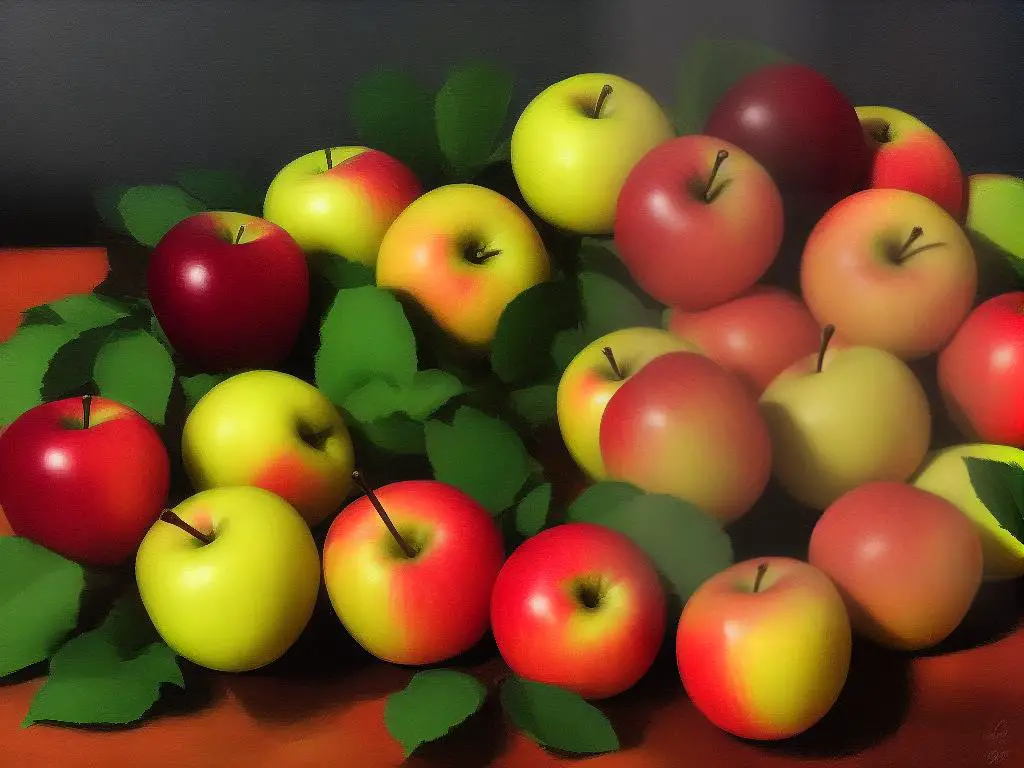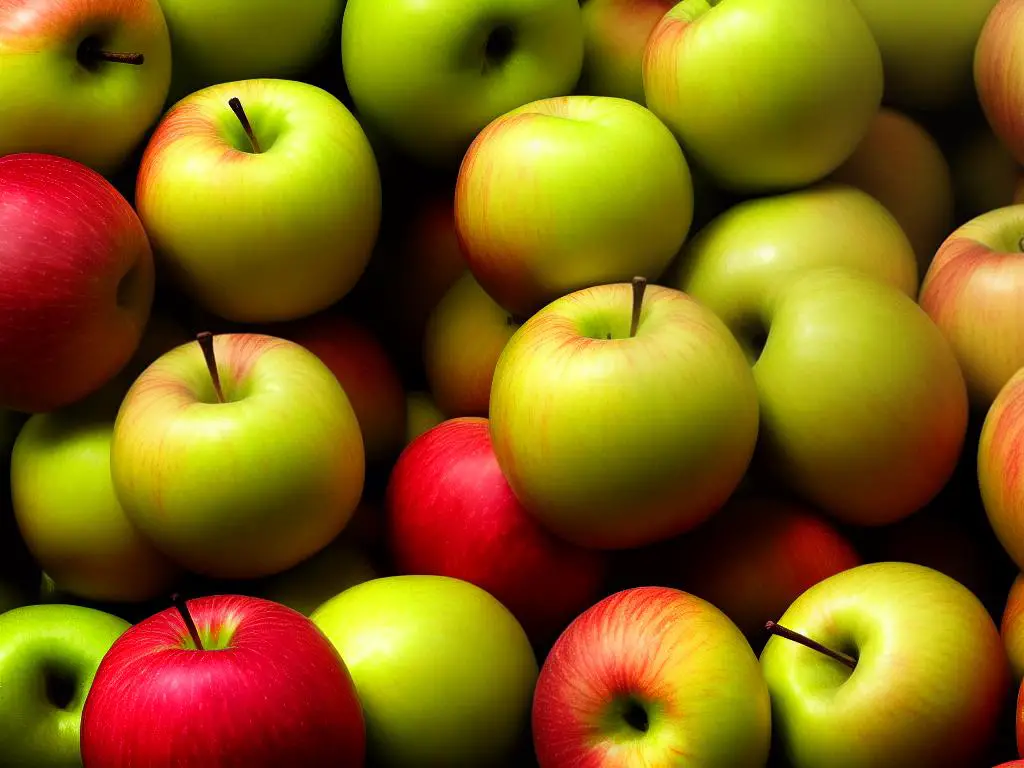The humble apple is a fruit like no other, offering a plethora of varieties, each with its unique taste and beauty. Out of these many compelling types, one that stands out is the Jonagold Apple. Renowned for its exquisite balance of sweet and tart flavors, the history and significance of this variety are deeply rooted and fascinating.
In this comprehensive feature, we will explore the captivating story of Jonagold apples, their unique characteristics that earned wide acclaim, and the intricate process of their cultivation and production.
Origin and History of Jonagold Apples
Origin and History of Jonagold Apples
Jonagold apples are a popular variety known for their honey-tart flavor and large, round shape. They are a cross between the crisp Golden Delicious and the tart Jonathan apples, combining the best features of both. This apple variety is unique in its coloration; the Jonagold’s skin is a lovely blend of green and red hues, though some can appear more yellow depending on their ripeness.
First Cultivation
The cultivation of Jonagold apples began in the mid-20th century at the New York State Agricultural Experiment Station in Geneva, New York. A man named Dr. Roger D. Way, who served as the Station’s fruit breeder for almost 50 years, created the Jonagold apple in 1943. However, it wasn’t introduced to the market until 1968.
Development of Jonagold Apples
The development and cultivation of the Jonagold apple is a testament to the power of careful selection and hybridization in fruit breeding. As a cross between the Jonathan and Golden Delicious varieties, Jonagold apples were designed to take on the crispness of Golden Delicious with the sweet-tart flavor of Jonathan apples.
The Jonagold’s size is typically larger than either of its parent apple varieties, making it an attractive choice for baking and eating. This apple type possesses an exquisite balance of flavors, mingling sweetness and tartness in just the right proportions.
Historical Significance
Born in America but adored across the globe, the Jonagold apple boasts a rich historical journey. It rose to fame for its exquisite blend of taste, size, and aesthetics, with an especially notable demand in Belgium, surpassing even the iconic Golden Delicious.
The cultivation of the Jonagold apple was a key moment in apple production, as it demonstrated the successful hybridization of apples to meet specific market needs. Its selective breeding paved the way for numerous apple cultivars that continue to grace our grocery aisles and fruit baskets today.
Since its inception, the Jonagold apple has received numerous accolades for its superior flavor and quality— a testament to its historical significance. The apple’s growing global footprint, spanning the United States to Europe, Japan, and Australia, reflects this success story.

Characteristics and Uses of Jonagold Apples
Introduction to Jonagold Apples
Meet the Jonagold apple — a robustly flavored variety adored for its perfect balance of tart and sweet. This apple cultivar is the lovechild of the crisp Golden Delicious and the tangy Jonathan apples, from which its name “Jonagold” was derived. Bred in the 1950s by the New York State Agricultural Experiment Station, Jonagold apples quickly captivated the hearts of apple lovers far and wide, thanks to their unique flavor profile and versatile use.
Physical Characteristics of Jonagold Apples
Jonagold apples are medium to large in size, with a round to slightly elongated shape. These apples boast a lovely skin color, typically featuring hues of yellow from the Golden Delicious parent, overlaid with a red or crimson blush reminiscent of Jonathan apples. The skin has a smooth, slightly glossy satin-like texture, which can be a bit tougher compared to other apple varieties, but it’s certainly not off-putting.
Observers might find the flesh of Jonagold apples as delightful as its skin. Once cut open, it reveals a creamy yellow to almost white flesh that’s firm, crisp, and juicy. These attributes make it a delight to bite into, be it as a fresh snack or cooked in culinary creations.
Flavor Characterization of Jonagold Apples
The flavor of Jonagold apples beautifully showcases the best of both its parents. It balances the full-bodied, honey-like sweetness of the Golden Delicious with the lively, mildly tart flavor of the Jonathan, resulting in a rich and complex taste. This apple variety can satisfy those who prefer either sweet or tart flavors due to its intricate palette, making it a greatly appreciated choice among many.
Culinary Uses of Jonagold Apples
Jonagold apples are incredibly versatile when it comes to culinary applications. Their well-rounded taste and firm, juicy flesh make them excellent for fresh consumption, such as in fruit salads, apple slaws OR as a garnish for drinks. They are perfect for snacking due to their large size, crisp structure, and dietary fiber content.
In the realm of baked goods, Jonagold apples shine in pies, tarts, muffins, and cakes. When baked, these apples retain their shape and provide a sweet-tart effect that complements sugary dessert preparations. The apple’s natural juiciness makes it especially worthwhile in moist cakes and breads.
Beyond baking, Jonagold apples can play a starring role in savory dishes. They can be baked with meats, added to stuffing, or mixed into salads for a burst of fresh, fruity flavor that can balance rich, heavy components. Whether they’re used in a savory apple chutney, a traditional apple sauce, or roasted alongside pork, Jonagold apples infuse a lovely flavor.
Exploring The Versatility of Jonagold Apples
The plethora of uses of Jonagold apples extends beyond culinary purposes. Not only are they an exceptional source of necessary nutrients like fiber and vitamin C, but their delightful aroma has found its way into various home fragrance products, such as candles and potpourri. Be it cooking with them or munching them as a nutritious snack, Jonagold apples have a lot to offer in terms of health benefits and taste.

Cultivation and Production
The Journey of Jonagold Apples From The Orchard To Your Basket
Originated as a crossbreed between the Golden Delicious and Jonathan apple, the Jonagold apple, known scientifically as Malus domestica Jonagold, is an exceptional fruit revered for its delicious taste. Balancing sweet and tart flavors, these apples are a delight to eat fresh and are often a top choice for culinary use.
Mid-20th century saw the emergence of this apple from a breeding program at Cornell University’s New York State Agricultural Experiment Station. The distinctive flavor and interior texture put Jonagold apples on the map. Enhancing their appeal is their striking appearance – a blend of yellow and green overtones accentuated by blush red hues.
Plantation and Nurturing of Jonagold Apples
Growing Jonagold apples require cool climates, where they can truly bloom in sunlight and mild temperatures. The trees are planted during late winter or early spring when they are dormant. They prefer slightly acidic soil, ideally with a pH between 6.0 and 7.0. Regularly applying organic compost or well-rotted manure can help improve the soil fertility necessary for their growth.
To cultivate a healthy Jonagold apple tree, it is essential to water it adequately, particularly during the dry spells. Pruning the tree in late winter or early spring assists in maintaining its shape and encourages the growth of more fruits.
Harvesting of Jonagold Apples
Jonagold apples mature and are ready for harvest in mid to late fall. As these fruits do not ripen all at once, multiple harvests may be necessary. The ripeness of the apple can be determined by its coloration—a ripe Jonagold apple should exhibit a majority of yellow color with a blush of red, while an underlying green color indicates unripeness.
Global Producers
As one of the most popular apple varieties, Jonagold apples are produced in large quantities worldwide. The largest producers naturally comprise countries with suitable climates for apple cultivation. This includes regions of the United States, particularly Washington and New York, parts of Europe like Belgium and the Netherlands, and the United Kingdom.
Jonagold Apples in the Apple Market
The global apple market greatly benefits from the Jonagold variety. Its versatility in usage—ranging from fresh consumption to baking and cider-making—have increased its demand amongst consumers. Plus, due to their high yield, Jonagold trees provide an excellent return on investment for apple growers. As such, Jonagold apples continue to be a popular choice contributing well to the overall growth and dynamics of the global apple market.

The vibrant history, the beneficial characteristics of Jonagold apples, combined with their wide-ranging uses, have brought them global recognition. Their influence extends far beyond their delectable flavor and their role in culinary delights. From its historical significance to its contribution to the world apple market, Jonagold apples have proven to be more than just an appetizing snack. Their ability to thrive and enhance various cuisines worldwide truly makes the Jonagold Apple an undeniably integral part of our food culture.